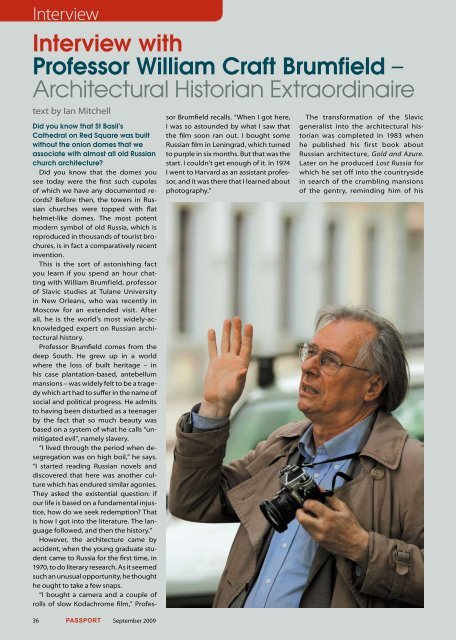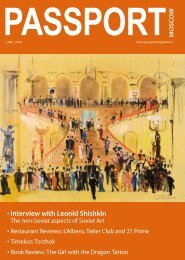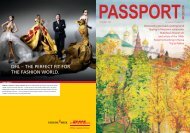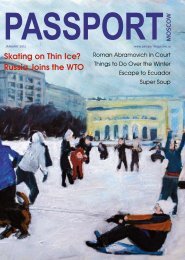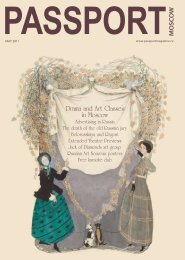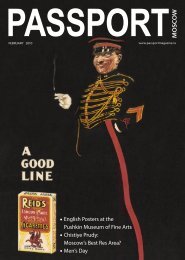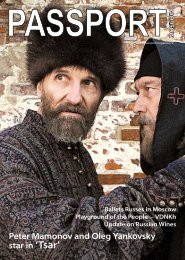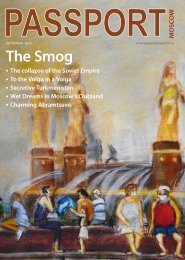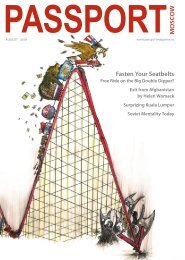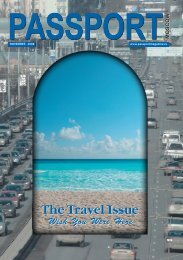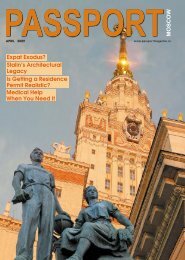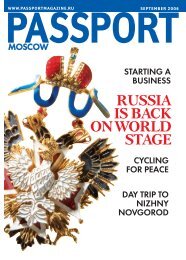Post-Perestroika Warrior - Passport magazine
Post-Perestroika Warrior - Passport magazine
Post-Perestroika Warrior - Passport magazine
Create successful ePaper yourself
Turn your PDF publications into a flip-book with our unique Google optimized e-Paper software.
Interview<br />
Interview with<br />
Professor William Craft Brumfield –<br />
Architectural Historian Extraordinaire<br />
text by Ian Mitchell<br />
Did you know that St Basil’s<br />
Cathedral on Red Square was built<br />
without the onion domes that we<br />
associate with almost all old Russian<br />
church architecture?<br />
Did you know that the domes you<br />
see today were the first such cupolas<br />
of which we have any documented records?<br />
Before then, the towers in Russian<br />
churches were topped with flat<br />
helmet-like domes. The most potent<br />
modern symbol of old Russia, which is<br />
reproduced in thousands of tourist brochures,<br />
is in fact a comparatively recent<br />
invention.<br />
This is the sort of astonishing fact<br />
you learn if you spend an hour chatting<br />
with William Brumfield, professor<br />
of Slavic studies at Tulane University<br />
in New Orleans, who was recently in<br />
Moscow for an extended visit. After<br />
all, he is the world’s most widely-acknowledged<br />
expert on Russian architectural<br />
history.<br />
Professor Brumfield comes from the<br />
deep South. He grew up in a world<br />
where the loss of built heritage – in<br />
his case plantation-based, antebellum<br />
mansions – was widely felt to be a tragedy<br />
which art had to suffer in the name of<br />
social and political progress. He admits<br />
to having been disturbed as a teenager<br />
by the fact that so much beauty was<br />
based on a system of what he calls “unmitigated<br />
evil”, namely slavery.<br />
“I lived through the period when desegregation<br />
was on high boil,” he says.<br />
“I started reading Russian novels and<br />
discovered that here was another culture<br />
which has endured similar agonies.<br />
They asked the existential question: if<br />
our life is based on a fundamental injustice,<br />
how do we seek redemption? That<br />
is how I got into the literature. The language<br />
followed, and then the history.”<br />
However, the architecture came by<br />
accident, when the young graduate student<br />
came to Russia for the first time, in<br />
1970, to do literary research. As it seemed<br />
such an unusual opportunity, he thought<br />
he ought to take a few snaps.<br />
“I bought a camera and a couple of<br />
rolls of slow Kodachrome film,” Profes-<br />
September 2009<br />
sor Brumfield recalls. “When I got here,<br />
I was so astounded by what I saw that<br />
the film soon ran out. I bought some<br />
Russian film in Leningrad, which turned<br />
to purple in six months. But that was the<br />
start. I couldn’t get enough of it. In 1974<br />
I went to Harvard as an assistant professor,<br />
and it was there that I learned about<br />
photography.”<br />
The transformation of the Slavic<br />
generalist into the architectural historian<br />
was completed in 1983 when<br />
he published his first book about<br />
Russian architecture, Gold and Azure.<br />
Later on he produced Lost Russia for<br />
which he set off into the countryside<br />
in search of the crumbling mansions<br />
of the gentry, reminding him of his


